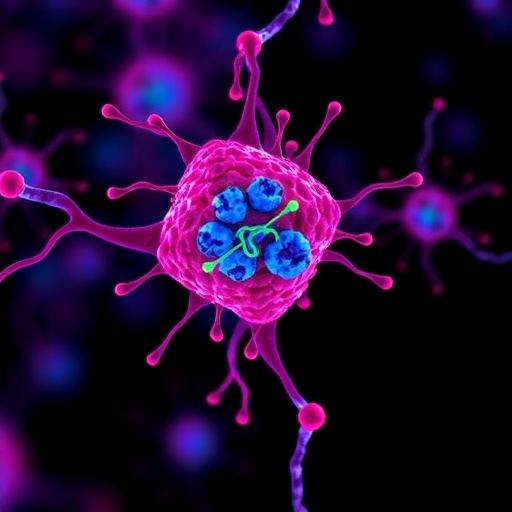
In a groundbreaking study emerging from Tokyo Metropolitan University, scientists have unveiled a novel molecular pathway that elucidates how cells defend themselves against the toxic effects of alovudine, a chain-terminating nucleoside analog (CTNA) with potent antiviral and anticancer capabilities. This discovery spotlights the critical role of flap endonuclease-1 (Fen1), a DNA repair enzyme traditionally overshadowed by better-known proteins, in thereby expanding our understanding of DNA replication fidelity and offering promising avenues for therapeutic advancements.
Chain-terminating nucleoside analogs like alovudine function by mimicking natural nucleosides and integrating into replicating DNA strands, selectively arresting DNA polymerization by causing premature chain termination. Due to the elevated replication rates in virally infected and cancerous cells, these analogs preferentially target malignant or infected tissues, forcibly halting proliferation. However, the clinical utility of alovudine has encountered significant complications, chiefly toxicity in healthy cells, which led to the discontinuation of certain clinical trials despite its antiviral promise.
The investigative team, led by Professor Kouji Hirota, focused on decoding cellular mechanisms that circumvent CTNA toxicity, aiming to delineate why some healthy cells can tolerate such reagents better than others. Prior research had highlighted breast cancer type I susceptibility protein (BRCA1) as a pivotal mediator of DNA repair and tolerance to alovudine, but the complexities of this resistance network pointed to additional players. Fen1, an enzyme primarily responsible for processing Okazaki fragments during lagging-strand DNA synthesis by cleaving single-stranded DNA flaps, now emerges as a crucial protagonist in this defense.
.adsslot_p1yvancSdo{width:728px !important;height:90px !important;}
@media(max-width:1199px){ .adsslot_p1yvancSdo{width:468px !important;height:60px !important;}
}
@media(max-width:767px){ .adsslot_p1yvancSdo{width:320px !important;height:50px !important;}
}
ADVERTISEMENT
By employing genetically engineered chicken DT40 cells, a versatile model in molecular genetics research, the team was able to demonstrate that loss of Fen1 function drastically undermines cellular resilience to alovudine. Cells deficient in Fen1 displayed markedly compromised replication kinetics, indicating an accumulation of replication stress and stalled forks. This impairment suggested that Fen1’s ability to process DNA flaps is indispensable for maintaining the integrity of replication in the presence of chain-terminating agents.
Intriguingly, the researchers uncovered a counterintuitive genetic interaction: when 53BP1, a protein that recognizes and binds to double-strand DNA breaks, was simultaneously knocked down in Fen1-deficient cells, alovudine tolerance was substantially restored. 53BP1 is known for its role in orchestrating DNA damage responses, particularly in non-homologous end joining repair pathways. The study proposes that in the absence of Fen1, persistent long ssDNA flaps accumulate and recruit 53BP1, which likely obstructs alternative flap-cleaving pathways, thereby exacerbating replication termination. Loss of 53BP1 relieving this blockade permits other nucleases or repair systems to circumvent the roadblock, allowing DNA replication and repair to proceed.
Crucially, the team revisited their earlier findings surrounding BRCA1 and homologous recombination (HR), a high-fidelity repair process. They observed that HR and Fen1 operate through parallel, additive pathways to mediate cellular tolerance to alovudine. Suppressing either pathway alone compromised resistance moderately, but simultaneous inhibition resulted in severe susceptibility. This delineation confirms that Fen1’s role is independent of BRCA1-mediated HR, representing a separate, yet equally vital, safeguard against replication stress induced by nucleoside analogs.
The implications of these findings extend beyond basic science, illuminating an underappreciated mechanism by which cells maintain genomic stability amid synthetic drug-induced stress. Fen1’s regulatory control over flap processing ensures continuity and completion of DNA replication even in the face of nucleoside analog-induced lesions. This newfound awareness opens potential therapeutic strategies: modulating Fen1 activity could enhance the efficacy and selectivity of antiviral and chemotherapeutic agents, tipping the balance toward cytotoxicity in malignant cells while sparing normal tissues.
Moreover, the study posits that Fen1 expression levels could serve as a biomarker to predict patient responses to CTNA-based treatments. Many cancer cells exhibit Fen1 dysregulation or deficiency, which could be exploited clinically to customize therapeutic regimens that maximize tumor suppression while minimizing systemic toxicity. Such precision medicine approaches could revolutionize cancer therapy by leveraging the cell’s own DNA repair machinery as a determinant for drug sensitivity.
Future directions include extending this research into human cell models to validate these molecular interactions and elucidate tissue-specific responses, particularly in solid tumors where treatment resistance remains a formidable challenge. Understanding the spatial and temporal dynamics of Fen1 and 53BP1 interplay in different cellular contexts may unveil further nuances guiding therapeutic decision-making.
Overall, the study represents a significant advance in molecular genetics and pharmacology, emphasizing the intricate balance cells maintain to manage DNA damage and replication stress. By shining a light on Fen1’s crucial function, researchers have not only clarified a key cellular defense against chain-terminating nucleoside analogs but also paved the way for innovative strategies in antiviral and cancer treatment development.
This work received substantial support from various prestigious funding bodies, including several grants from the Japan Society for the Promotion of Science (JSPS KAKENHI), the Tokyo Metropolitan Government Advanced Research program, the Takeda Science Foundation, and the Uehara Memorial Foundation. Their backing underscores the profound significance and promising translational potential of these findings in the realm of biomedical sciences.
Subject of Research: DNA repair mechanisms and cellular tolerance to chain-terminating nucleoside analogs (CTNAs) with a focus on flap endonuclease-1 (Fen1) and 53BP1 protein interactions.
Article Title: The flap endonuclease-1 promotes cellular tolerance to a chain-terminating nucleoside analog, alovudine, by counteracting the toxic effect of 53BP1
News Publication Date: 22-Jul-2025
Web References: 10.1093/nar/gkaf617
Image Credits: Tokyo Metropolitan University
Keywords: DNA repair, Cancer medication, Genetics, Molecular biology, Protein functions, Cell biology, DNA replication, Protein interactions, Molecular genetics, Drug sensitivity, Antivirals, Chemotherapy, DNA damage responses
Tags: advancements in anticancer therapyalovudine and its therapeutic potentialBRCA1 and DNA repair mechanismscancer cell replication and drug resistancecellular tolerance to anticancer drugschain-terminating nucleoside analogs mechanismflap endonuclease-1 role in DNA repairimplications for antiviral drug developmentnovel molecular pathways in cancer treatmentovercoming toxicity in healthy cellsTokyo Metropolitan University cancer researchunderstanding DNA replication fidelity





